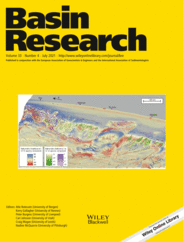-
oa Effects of basement structures and Carboniferous basin configuration on evaporite distribution and the development of salt structures in Nordkapp Basin, Barents Sea—Part I
- Source: Basin Research, Volume 33, Issue 4, Jul 2021, p. 2474 - 2499
-
- 07 Dec 2020
- 26 Mar 2021
- 12 May 2021
Abstract
The rheological properties, locations, orientations and interaction of the Timanian and Caledonian structures together with two subsequent extensional phases strongly influenced the presalt rift architecture and gave rise to seven subbasins in the Nordkapp Basin. The relative depth of each subbasin in contrast to the margin, cross‐cutting master faults, structural highs arrangement and depositional paleo‐environment controlled the thickness and facies of the synrift to early postrift layered evaporite sequence.
Potential field data, reprocessed regional 2D seismic reflection profiles and 3D seismic tied to wells were used to study the late Devonian‐Permian development of the Nordkapp Basin in Barents Sea. The composite basin can be subdivided into the northeastern, central and southwestern segments that developed above a basement that contains elements of the Timanian and Caledonian regimes. The transition between the Timanian and Caledonian structures is positioned below the central basin segment. The rheological properties, locations, orientations and interaction of inherited structures together with two subsequent extensional phases, defined the presalt rift architecture and gave rise to seven subbasins within Nordkapp Basin. During the late Devonian‐early Carboniferous NE‐SW oriented extension, the basin consisted of two regional half‐grabens (northern and southern) separated by an interbasin ridge. During the late Carboniferous, the shift of extension direction to NW‐SE orientation reshaped the two regional half‐grabens. In particular, an interbasin transfer zone divided the northern regional half‐graben by separating its hinged‐margin portion (incipient northeastern segment) from the deeper part (incipient central segment). At the same time, the elevated interbasin ridge separated the incipient central and southwestern segments. Internally within the seven subbasins, the evolving structural elements including cross‐cutting master faults and structural highs have influenced the deposition and character of the Pennsylvanian‐lower Permian layered evaporite sequence and the distribution of subsequent salt structures. We suggest that the synrift to early postrift processes, relative depth of each subbasin, arrangement of the structural highs and depositional palaeo‐environment all controlled the thickness and facies of the layered evaporite sequence. The latter in combination with the presalt architecture comprised a laterally varying in thickness and character substratum that during the earliest Triassic influenced the sediment routings and deposition of the progradational system arriving in Nordkapp Basin. The study outcomes are pertinent and applicable to other salt‐influenced rift basins worldwide.
]



